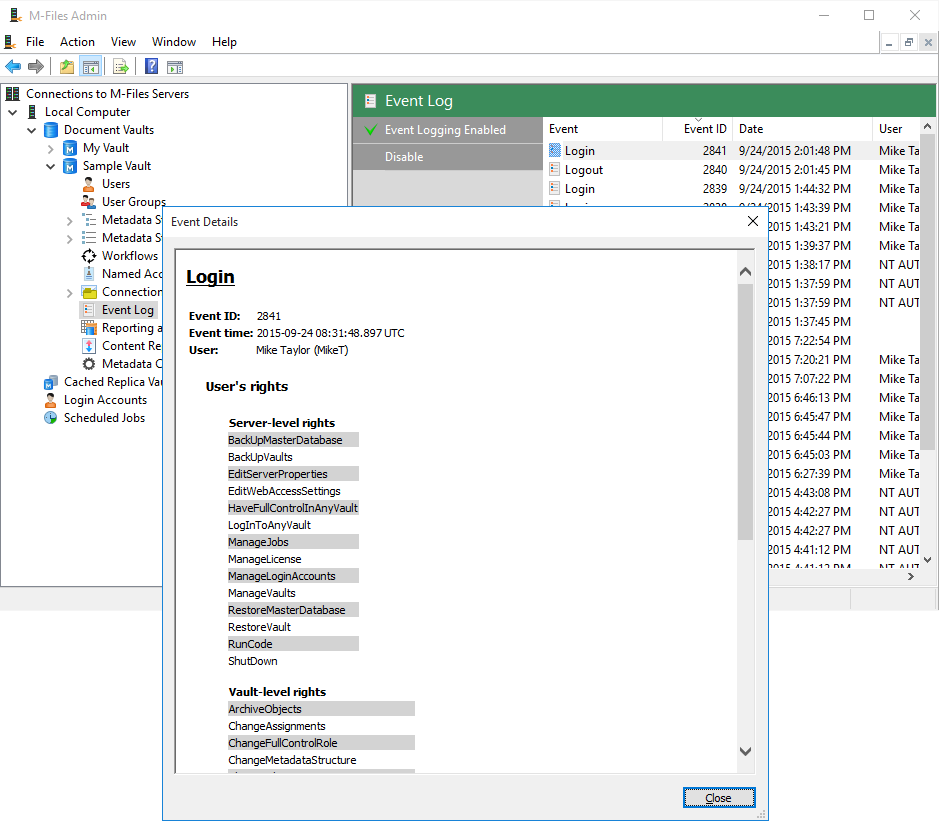The Event Log logs document vault events, such as new object creations and user logins.
To enable logging, select Enable Event Logging via the task pane. Events can be viewed and organized in any desired order.
Event logging must be enabled to send notifications. For more information about notifications, refer to Notification Settings (M-Files Admin).
Showing events X–XXXX
You can browse the events page by page by using the arrow icons. A single page can display 10,000 events at maximum.
Define Filter
You can specify the events to be displayed in the list by either object type or object ID.
Export
You can export and archive all or selected events in XML file format.
Delete events X–XXXX
In addition to being able to delete all events, you can select events for listing on the page and delete them (this does not apply to filtered lists).
Video: Event Logs
Detailed information on an individual event
Event Details provides detailed information on the saved changes.

The "Event Details" window.
Number of events, and event types
If the Electronic Signatures module is in use and the Advanced Event Log features have been enabled, the event log records all events without any restrictions. Otherwise, the M-Files server removes the oldest events automatically if the number of events exceeds 10,000. The maximum number of events can be changed via a registry setting (for more information, contact M-Files customer support).
While M-Files offers a versatile event log, several additional event types that can be covered by logging are enabled with the Electronic Signatures module.
The following event types are recorded in the M-Files Admin event log:
| Assign request | Document vault created as a copy of another vault | Object changed | Signature settings modified |
| Backup completed | Event log cleared | Object deleted | State changed |
| Backup started | Event log exported | Object destroyed | The state of a document or other object changed |
| Check-in | Event logging disabled | Object undeleted | User created |
| Check-in request | Event logging enabled | Object version destroyed | User deleted |
| Checkout | File downloaded | One version of a document or other object destroyed | User modified |
| Undo checkout | Free-form request | Property definition deleted | User group created |
| Document or other object changed | Login | Restoration from backup completed | User group deleted |
| Document or other object deleted | Logout | Rollback | User group modified |
| Document or other object destroyed | New document or other object | Signature settings added | Vault variable modified |
| Document vault created | New object | Signature settings deleted |
The Electronic Signatures module adds the following event types to the M-Files Admin event log:
| Metadata structure changes: | |||
| Class changed | Named ACL deleted | State transition changed | Value list item deleted |
| Class created | Object type changed | State transition created | Workflow changed |
| Class deleted | Object type created | State transition deleted | Workflow created |
| Common view changed | Object type deleted | Value list changed | Workflow deleted |
| Common view created | Property definition created | Value list created | |
| Common view deleted | Property definition changed | Value list deleted | |
| Named ACL changed | State created | Value list item changed | |
| Named ACL created | State deleted | Value list item created |
| Vault property changes: |
| Event handler changed |
| Event handler created |
| Event handler deleted |
| Event handler index changed |
| Other: |
| Application installed |
| Application uninstalled |
| Content package exported |
| Content package import completed |
Electronic Signatures module
The Electronic Signatures module includes event logging extensions and electronic signature functionality. The module is available for a separate fee. For you to activate the Electronic Signatures module, the license code must be activated on your system. The license is provided on a subscription basis. Activate or update the license code in M-Files Admin (for more information, refer to License Management). In addition to this, properties of the audit trail must be activated that are specific to the vault. For more information, see Document Vault Advanced Properties.